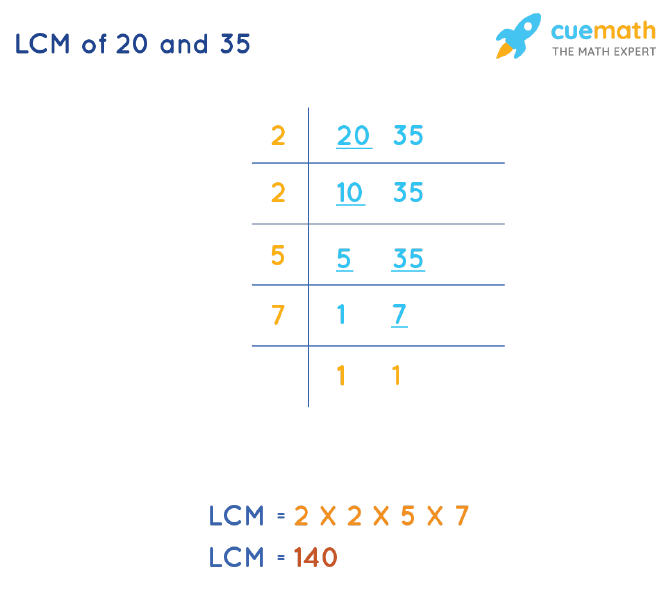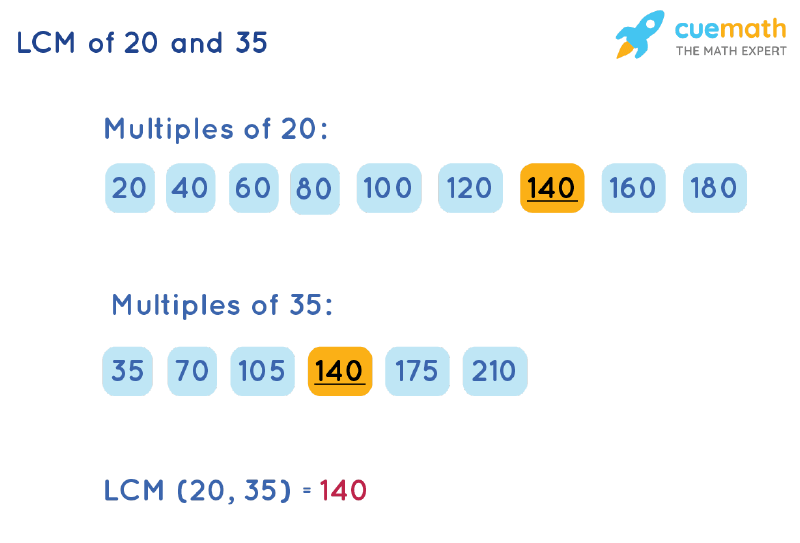LCM of 20 and 35
LCM of 20 and 35 is the smallest number among all common multiples of 20 and 35. The first few multiples of 20 and 35 are (20, 40, 60, 80, 100, . . . ) and (35, 70, 105, 140, 175, 210, . . . ) respectively. There are 3 commonly used methods to find LCM of 20 and 35 - by division method, by listing multiples, and by prime factorization.
| 1. | LCM of 20 and 35 |
| 2. | List of Methods |
| 3. | Solved Examples |
| 4. | FAQs |
What is the LCM of 20 and 35?
Answer: LCM of 20 and 35 is 140.

Explanation:
The LCM of two non-zero integers, x(20) and y(35), is the smallest positive integer m(140) that is divisible by both x(20) and y(35) without any remainder.
Methods to Find LCM of 20 and 35
The methods to find the LCM of 20 and 35 are explained below.
- By Division Method
- By Prime Factorization Method
- By Listing Multiples
LCM of 20 and 35 by Division Method

To calculate the LCM of 20 and 35 by the division method, we will divide the numbers(20, 35) by their prime factors (preferably common). The product of these divisors gives the LCM of 20 and 35.
- Step 1: Find the smallest prime number that is a factor of at least one of the numbers, 20 and 35. Write this prime number(2) on the left of the given numbers(20 and 35), separated as per the ladder arrangement.
- Step 2: If any of the given numbers (20, 35) is a multiple of 2, divide it by 2 and write the quotient below it. Bring down any number that is not divisible by the prime number.
- Step 3: Continue the steps until only 1s are left in the last row.
The LCM of 20 and 35 is the product of all prime numbers on the left, i.e. LCM(20, 35) by division method = 2 × 2 × 5 × 7 = 140.
LCM of 20 and 35 by Prime Factorization
Prime factorization of 20 and 35 is (2 × 2 × 5) = 22 × 51 and (5 × 7) = 51 × 71 respectively. LCM of 20 and 35 can be obtained by multiplying prime factors raised to their respective highest power, i.e. 22 × 51 × 71 = 140.
Hence, the LCM of 20 and 35 by prime factorization is 140.
LCM of 20 and 35 by Listing Multiples

To calculate the LCM of 20 and 35 by listing out the common multiples, we can follow the given below steps:
- Step 1: List a few multiples of 20 (20, 40, 60, 80, 100, . . . ) and 35 (35, 70, 105, 140, 175, 210, . . . . )
- Step 2: The common multiples from the multiples of 20 and 35 are 140, 280, . . .
- Step 3: The smallest common multiple of 20 and 35 is 140.
∴ The least common multiple of 20 and 35 = 140.
☛ Also Check:
- LCM of 24, 36 and 48 - 144
- LCM of 105 and 195 - 1365
- LCM of 4, 5 and 6 - 60
- LCM of 9 and 11 - 99
- LCM of 16 and 40 - 80
- LCM of 75 and 80 - 1200
- LCM of 8, 15 and 21 - 840
LCM of 20 and 35 Examples
-
Example 1: The GCD and LCM of two numbers are 5 and 140 respectively. If one number is 20, find the other number.
Solution:
Let the other number be m.
∵ GCD × LCM = 20 × m
⇒ m = (GCD × LCM)/20
⇒ m = (5 × 140)/20
⇒ m = 35
Therefore, the other number is 35. -
Example 2: The product of two numbers is 700. If their GCD is 5, what is their LCM?
Solution:
Given: GCD = 5
product of numbers = 700
∵ LCM × GCD = product of numbers
⇒ LCM = Product/GCD = 700/5
Therefore, the LCM is 140.
The probable combination for the given case is LCM(20, 35) = 140. -
Example 3: Find the smallest number that is divisible by 20 and 35 exactly.
Solution:
The smallest number that is divisible by 20 and 35 exactly is their LCM.
⇒ Multiples of 20 and 35:- Multiples of 20 = 20, 40, 60, 80, 100, 120, 140, . . . .
- Multiples of 35 = 35, 70, 105, 140, 175, . . . .
Therefore, the LCM of 20 and 35 is 140.

FAQs on LCM of 20 and 35
What is the LCM of 20 and 35?
The LCM of 20 and 35 is 140. To find the LCM of 20 and 35, we need to find the multiples of 20 and 35 (multiples of 20 = 20, 40, 60, 80 . . . . 140; multiples of 35 = 35, 70, 105, 140) and choose the smallest multiple that is exactly divisible by 20 and 35, i.e., 140.
What are the Methods to Find LCM of 20 and 35?
The commonly used methods to find the LCM of 20 and 35 are:
- Prime Factorization Method
- Listing Multiples
- Division Method
How to Find the LCM of 20 and 35 by Prime Factorization?
To find the LCM of 20 and 35 using prime factorization, we will find the prime factors, (20 = 2 × 2 × 5) and (35 = 5 × 7). LCM of 20 and 35 is the product of prime factors raised to their respective highest exponent among the numbers 20 and 35.
⇒ LCM of 20, 35 = 22 × 51 × 71 = 140.
If the LCM of 35 and 20 is 140, Find its GCF.
LCM(35, 20) × GCF(35, 20) = 35 × 20
Since the LCM of 35 and 20 = 140
⇒ 140 × GCF(35, 20) = 700
Therefore, the greatest common factor (GCF) = 700/140 = 5.
What is the Least Perfect Square Divisible by 20 and 35?
The least number divisible by 20 and 35 = LCM(20, 35)
LCM of 20 and 35 = 2 × 2 × 5 × 7 [Incomplete pair(s): 5, 7]
⇒ Least perfect square divisible by each 20 and 35 = LCM(20, 35) × 5 × 7 = 4900 [Square root of 4900 = √4900 = ±70]
Therefore, 4900 is the required number.
visual curriculum